7 /10 1 Votes7
Developer(s) Reakktor Media Release date(s) 21 March 2011 (EU) Publisher Gamigo | 70% Metacritic Initial release date 21 March 2011 | |||||||||||||||||||||||||||||||||
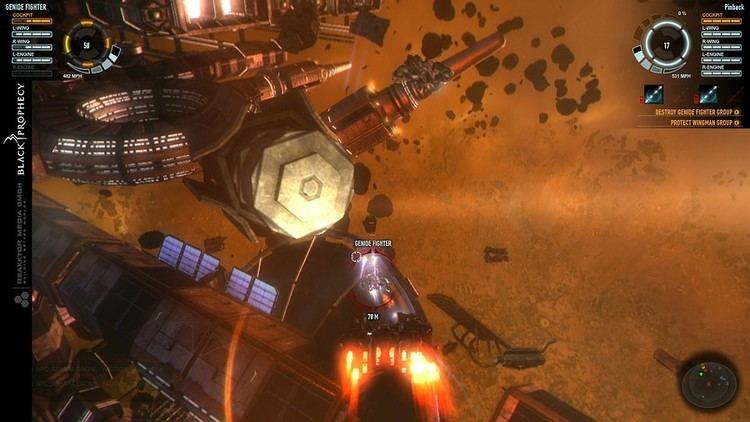 | ||||||||||||||||||||||||||||||||||
Genre(s) MMORPG Space simulation Similar Gamigo games, MMORPGs | ||||||||||||||||||||||||||||||||||
Black Prophecy was a 3D real-time space combat massively multiplayer online game by Reakktor Media GmbH, the creators of Neocron.
Contents
- Black prophecy launch trailer 2011
- Background
- Factions
- The Tyi
- The Genides
- Gameplay
- Development
- Termination
- References
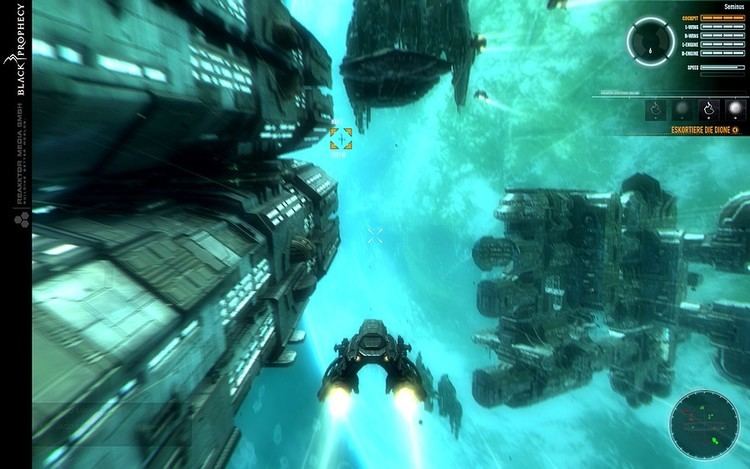
Reakktor Media started the open beta test phase of the game on February 2011, and they had teamed up with German distributor gamigo AG to publish the game.
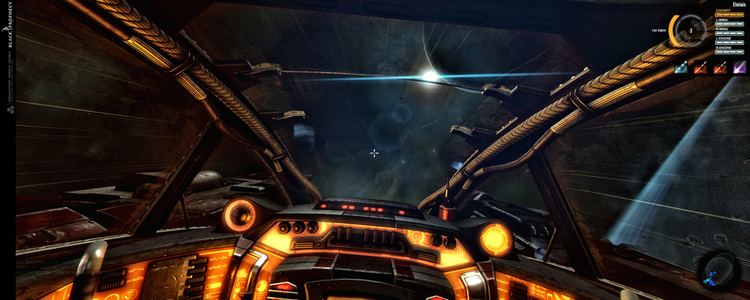
Black Prophecy was launched in Europe on 21 March 2011. The US version was launched later. The game was not made available to Asian and Australian players, with the official Black Prophecy website preventing residents of these regions from downloading the client executable file and signing up for beta access. The game used the Freemium model, featuring a premium shop where players could buy various in-game items, such as weapons and armors.
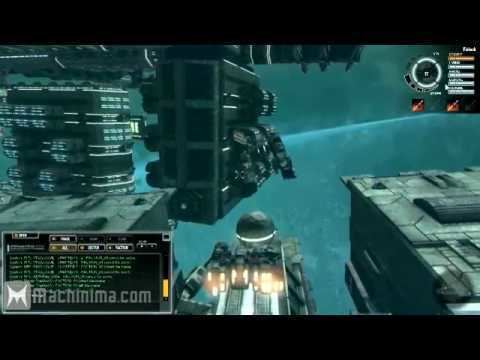
On 29 August 2012 the game developers announced that the game will be "closing its doors" on 26 September 2012.

Black prophecy launch trailer 2011
Background
Black Prophecy's setting and story have been developed by Sci-Fi author Michael Marrak.
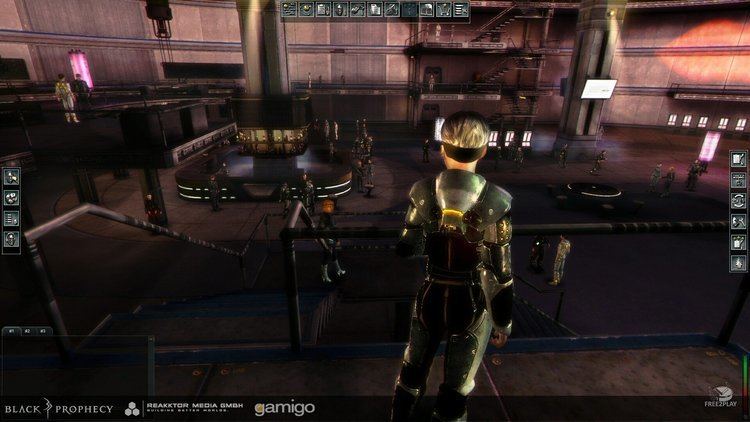
The game was set in the 26th century, where mankind has expanded across the galaxy, yet only few of its colonies are controlled by humans. Two main factions dominate space: the cybernetically enhanced humans the Tyi and the biogenetically perfected humans the Genides. On their quest for territorial domination they enter the territory of an ancient alien race called the Restorers, who exhibit a destructive behaviour to other civilizations.
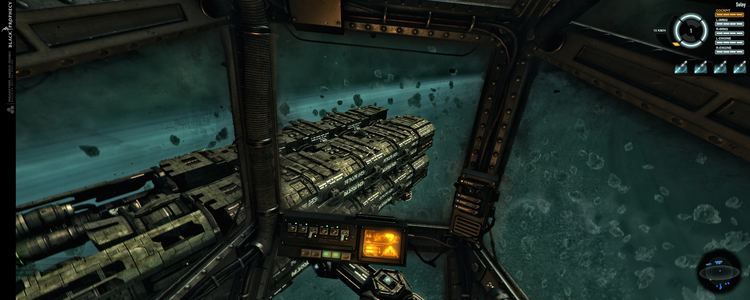
The player was asked to join one of these two dominant races of humans to uncover the mystery of the Restorers and grant the survival of the human species.
Factions
Two main factions dominated the game:
The Tyi
The Tyi (abbreviation for Tactical Yeomen Inhabitants, pronounced "tie") are a race of cybernetically enhanced superhumans, with great strength and endurance, both physically and mentally. They are resistant to radiation, have redundant circulatory systems as well as backup organs, speak all languages and are true multitaskers. They also gather and process data at a somewhat increased rate.
The Genides
The Genides are a race of genetically perfected humans, designed to be able to better resist the unusual and partially hostile environments in space and on the colony planets. They require very little sleep, heal wounds quickly and can communicate telepathically. In addition, most of them are resistant to disease and epidemics, think faster, can detect ultra- and infra-sounds and have a long life expectancy.
Gameplay
The game was action-oriented, focusing on player versus player (PvP) and player versus environment (PvE) combat and missions. Up to ten players could form a team and participate in team missions, which typically had an increased difficulty and better rewards compared to the solo missions. There were no bonuses for PvP combat other than the PvP mission rewards. The only death penalty was a stacking debuff to some of the ship's stats, which lasted for 5 minutes. After being destroyed, player ships left no wrecks and were instantly resurrected. Players retained all the items that were in their ship's inventory before death.
Players gained levels by getting experience from completing various missions. Each new level added 3 or 5 points which players allocated to increase the stats of their choice. Each stat determined the maximum level of equipment a player could use. For example, a level 10 mechanical stat allowed the use of any mechanical weapons up to level 10. The points could also be allocated in tactics stat, which allowed players to perform various combat maneuvers, such as U-turn and speed boost. Common items could be bought from the NPC dealers, which were present on most stations, but more advanced items could only be looted from enemies or crafted by players.
The game had no way to automate the trading process between players, it had neither an auction nor a market - the only way to trade for the players was to agree to meet in a certain place and transfer items and currency manually through the trading window.
The crafting system was similar to the one used in Korean MMORPGs, since it was based on random numbers. First, a player had to obtain a blueprint and the resources required for crafting. Then the player docked at a space station, selected the crafting menu, placed the blueprint on the corresponding slot and then checked the end result, which was shown before the crafting process started. Then the player started the crafting process, which took an amount of time based on the end product level. While crafting, the player wasn't able to do anything else, and only one item could be crafted at a time. If all did go well, the player got their product after the crafting was finished. The process had a chance to fail, in which case no product was produced and all of the resources used in production were lost. There was also a chance for a perfect crafting, which produced an item with stats better than originally anticipated. Such items could be sold for a very high price to other players.
A notable aspect of the game was the modular ship design, where players were able to acquire different modules (cockpits, wings, engines) of different levels in order to customize their ships in many ways. Most of the modules could also be modified, increasing some of their stats.
The game also featured an award and medal system, similar to an achievements system, where players could earn medals and awards for performing specific tasks.
Player clans were allowed to build their own stations and expand them through a module system to add different functionalities, similar to the NPC stations.
The game had three ship views available - two first person views from inside the cockpit with cockpit frame and the interface visible in one case and only the interface visible in the other, and a third person view of the ship.
Development
Development on Black Prophecy started in late 2006 with a team of 50 people. Originally planned to be released in 2009 by Reakktor's parent studio, 10tacle Studios, it was premiered during the 2007 Games Convention in Leipzig, Germany. The first website for the game was put online on 21 August 2007, just in time for the convention.
At the 2008 E3 a new trailer was debuted and the registration for the closed beta was opened.
After 10tacle's bankruptcy announcement on August 2008, Reakktor released a statement confirming their commitment to the development of the game.
The new website for the game was launched on 5 March 2009, and on 8 April 2009 the official forums were opened to the public. The game was released on 21 March 2011 in Europe.
Termination
On 29 August 2012 it was officially announced that Black Prophecy will be discontinued on 26 September 2012 due to financial issues.
